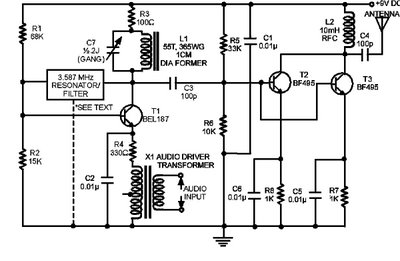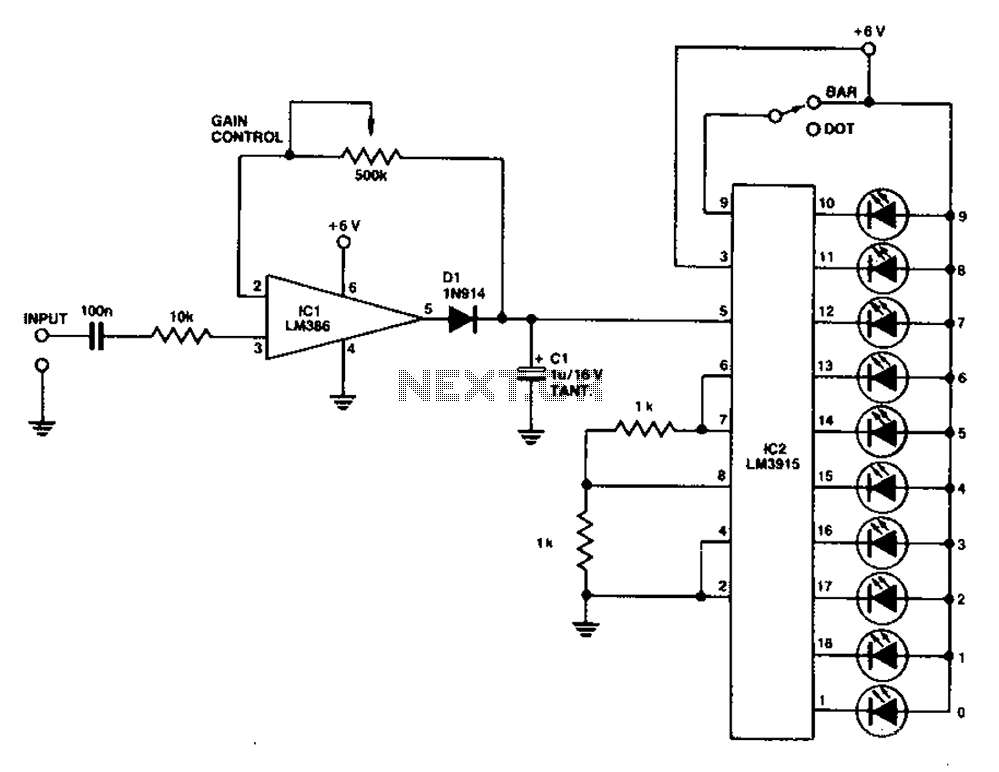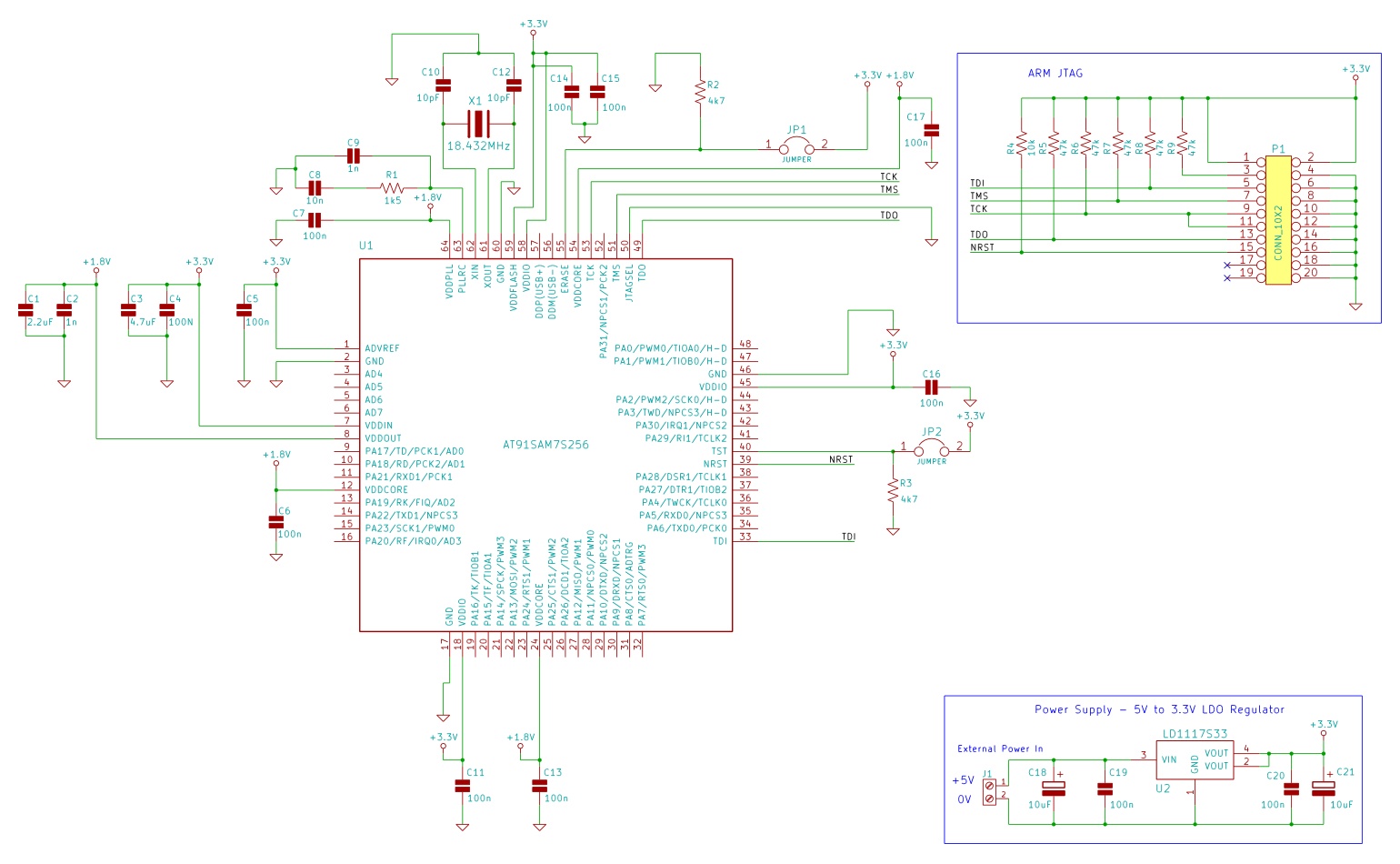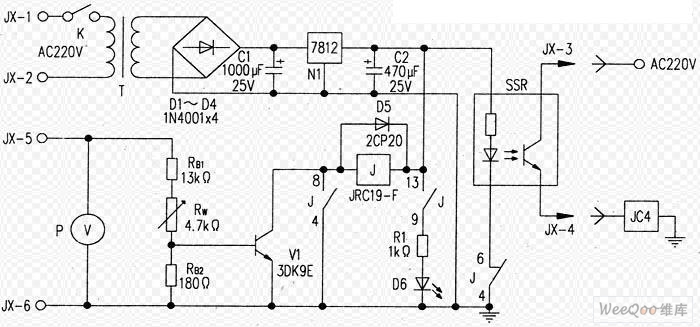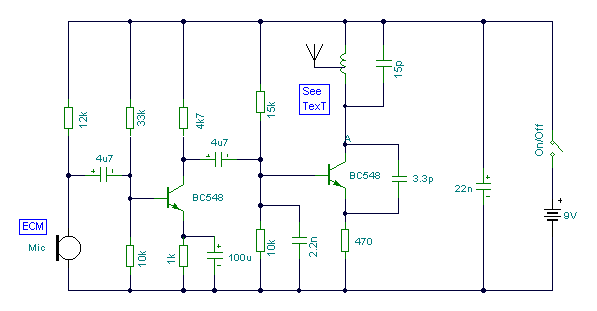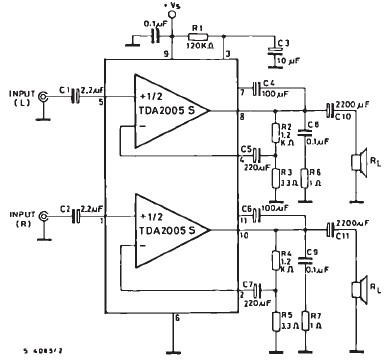
27mhz transmitter circuit

This design circuit is for a simple 27MHz transmitter that produces a carrier signal. The circuit generates an unmodulated 27MHz signal, which can be received by a compatible receiver. The transmitter operates as a basic crystal oscillator, with the core of the design being a tuned circuit that includes the primary winding of a transformer and a 10pF capacitor. These components oscillate when a voltage is applied. The frequency is fine-tuned using a ferrite slug positioned in the center of the coil until it matches the crystal frequency. The crystal ensures frequency stability across a wide range of temperature changes and supply voltage variations. The transistor is configured as a common emitter amplifier, featuring a resistor on the emitter for biasing. The 82pF capacitor across the 390Ω resistor effectively connects the emitter to the negative rail concerning the signal. The 390Ω resistor limits the current flowing through the transistor, given the low resistance of the transformer. The tuned circuit operates at the third harmonic (also known as the third overtone) of the crystal, allowing the crystal to oscillate at its third overtone frequency of 27MHz, thereby maintaining circuit frequency stability. The transformer connected to the collector of the transistor serves two essential purposes: it matches the transistor's impedance to the antenna's impedance and creates a resonant circuit at 27MHz, ensuring that the crystal oscillates at this frequency.
The 27MHz transmitter circuit is a straightforward yet effective design primarily utilized in low-power applications such as remote controls, hobbyist projects, and basic wireless communication systems. The crystal oscillator configuration is crucial for generating a stable carrier frequency, which is essential for reliable transmission and reception.
The tuned circuit, consisting of the transformer and the capacitor, plays a vital role in determining the oscillator frequency. The ferrite slug allows for precise adjustments, enabling the designer to compensate for any variations in the crystal's frequency due to environmental factors. This flexibility is particularly important in practical applications where temperature fluctuations may occur.
The common emitter amplifier configuration of the transistor provides necessary gain while ensuring that the output signal remains within acceptable limits. The inclusion of the emitter resistor aids in biasing the transistor, promoting linear operation, which is essential for maintaining signal integrity.
The choice of a 10pF capacitor in conjunction with the transformer helps achieve the desired resonant frequency, while the 390Ω resistor safeguards the transistor from excessive current, which could lead to thermal runaway or damage. The transformer not only matches impedances but also enhances the overall efficiency of the transmitter by ensuring maximum power transfer to the antenna.
In summary, this 27MHz transmitter circuit exemplifies a fundamental approach to RF design, combining essential components to create a robust and reliable oscillator capable of stable frequency generation, suitable for various wireless applications.This is a design circuit for a simple 27MHz transmitter producing a carrier. The circuit can produces an unmodulated 27MHz signal and when picked up by a receiver. This is the figure of the circuit; The transmitter is a very simple crystal oscillator. The heart of the circuit is the tuned circuit consisting of the primary of the transformer and a 10p capacitor. These two components oscillate when a voltage is applied to them. The frequency is adjusted by a ferrite slug in the centre of the coil until it is exactly the same as the crystal. The crystal will then maintain the frequency over a wide range of temperature and supply voltage fluctuations.
The transistor is configured as a common emitter amplifier. It has a resistor on the emitter for biasing purposes but the 82p across the 390R effectively takes the emitter to the negative rail as far as the signal is concerned. The 390R resistor prevents a high current passing through the transistor as the resistance of the transformer is very low.
The tuned circuit operates at exactly the third harmonic (also called the third overtone - an overtone is a multiple of a fundamental frequency) of the crystal so that the crystal will oscillate at its third overtone (27MHz) and in-turn, keep the frequency of the circuit stable. The transformer in the collector of the transistor performs two functions. 1. It matches the impedance of the transistor to the impedance of the antenna, and 2. Creates a resonant circuit at 27MHz to make sure the crystal oscillates at this frequency. 🔗 External reference
The 27MHz transmitter circuit is a straightforward yet effective design primarily utilized in low-power applications such as remote controls, hobbyist projects, and basic wireless communication systems. The crystal oscillator configuration is crucial for generating a stable carrier frequency, which is essential for reliable transmission and reception.
The tuned circuit, consisting of the transformer and the capacitor, plays a vital role in determining the oscillator frequency. The ferrite slug allows for precise adjustments, enabling the designer to compensate for any variations in the crystal's frequency due to environmental factors. This flexibility is particularly important in practical applications where temperature fluctuations may occur.
The common emitter amplifier configuration of the transistor provides necessary gain while ensuring that the output signal remains within acceptable limits. The inclusion of the emitter resistor aids in biasing the transistor, promoting linear operation, which is essential for maintaining signal integrity.
The choice of a 10pF capacitor in conjunction with the transformer helps achieve the desired resonant frequency, while the 390Ω resistor safeguards the transistor from excessive current, which could lead to thermal runaway or damage. The transformer not only matches impedances but also enhances the overall efficiency of the transmitter by ensuring maximum power transfer to the antenna.
In summary, this 27MHz transmitter circuit exemplifies a fundamental approach to RF design, combining essential components to create a robust and reliable oscillator capable of stable frequency generation, suitable for various wireless applications.This is a design circuit for a simple 27MHz transmitter producing a carrier. The circuit can produces an unmodulated 27MHz signal and when picked up by a receiver. This is the figure of the circuit; The transmitter is a very simple crystal oscillator. The heart of the circuit is the tuned circuit consisting of the primary of the transformer and a 10p capacitor. These two components oscillate when a voltage is applied to them. The frequency is adjusted by a ferrite slug in the centre of the coil until it is exactly the same as the crystal. The crystal will then maintain the frequency over a wide range of temperature and supply voltage fluctuations.
The transistor is configured as a common emitter amplifier. It has a resistor on the emitter for biasing purposes but the 82p across the 390R effectively takes the emitter to the negative rail as far as the signal is concerned. The 390R resistor prevents a high current passing through the transistor as the resistance of the transformer is very low.
The tuned circuit operates at exactly the third harmonic (also called the third overtone - an overtone is a multiple of a fundamental frequency) of the crystal so that the crystal will oscillate at its third overtone (27MHz) and in-turn, keep the frequency of the circuit stable. The transformer in the collector of the transistor performs two functions. 1. It matches the impedance of the transistor to the impedance of the antenna, and 2. Creates a resonant circuit at 27MHz to make sure the crystal oscillates at this frequency. 🔗 External reference
Warning: include(partials/cookie-banner.php): Failed to open stream: Permission denied in /var/www/html/nextgr/view-circuit.php on line 713
Warning: include(): Failed opening 'partials/cookie-banner.php' for inclusion (include_path='.:/usr/share/php') in /var/www/html/nextgr/view-circuit.php on line 713
